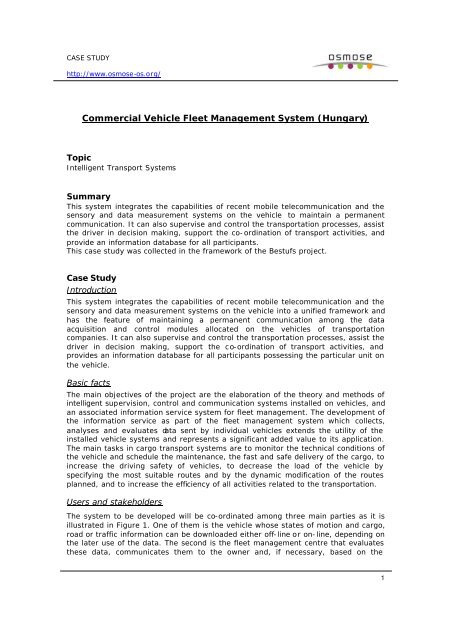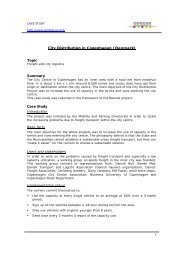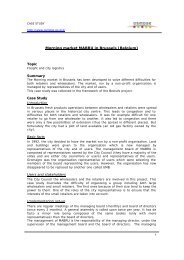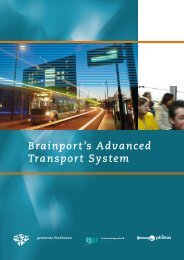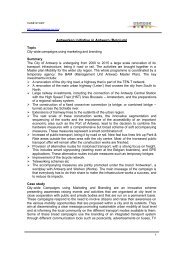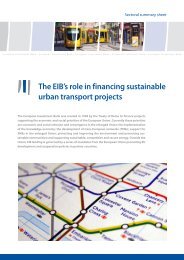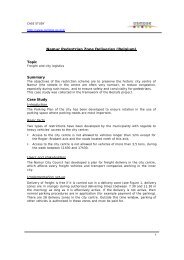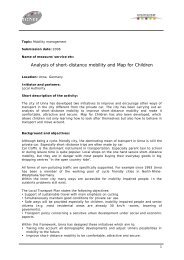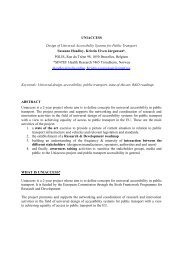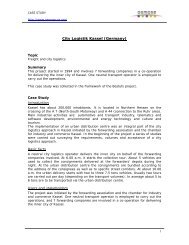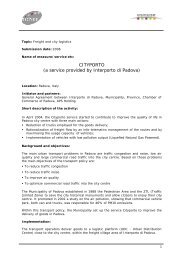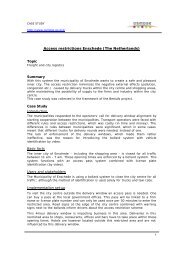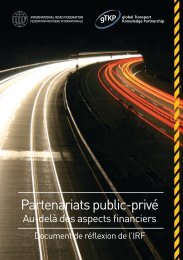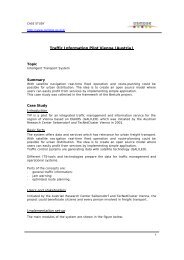Commercial Vehicle Fleet Management System (Hungary) - Osmose
Commercial Vehicle Fleet Management System (Hungary) - Osmose
Commercial Vehicle Fleet Management System (Hungary) - Osmose
Create successful ePaper yourself
Turn your PDF publications into a flip-book with our unique Google optimized e-Paper software.
CASE STUDY<br />
http://www.osmose-os.org/<br />
<strong>Commercial</strong> <strong>Vehicle</strong> <strong>Fleet</strong> <strong>Management</strong> <strong>System</strong> (<strong>Hungary</strong>)<br />
Topic<br />
Intelligent Transport <strong>System</strong>s<br />
Summary<br />
This system integrates the capabilities of recent mobile telecommunication and the<br />
sensory and data measurement systems on the vehicle to maintain a permanent<br />
communication. It can also supervise and control the transportation processes, assist<br />
the driver in decision making, support the co-ordination of transport activities, and<br />
provide an information database for all participants.<br />
This case study was collected in the framework of the Bestufs project.<br />
Case Study<br />
Introduction<br />
This system integrates the capabilities of recent mobile telecommunication and the<br />
sensory and data measurement systems on the vehicle into a unified framework and<br />
has the feature of maintaining a permanent communication among the data<br />
acquisition and control modules allocated on the vehicles of transportation<br />
companies. It can also supervise and control the transportation processes, assist the<br />
driver in decision making, support the co-ordination of transport activities, and<br />
provides an information database for all participants possessing the particular unit on<br />
the vehicle.<br />
Basic facts<br />
The main objectives of the project are the elaboration of the theory and methods of<br />
intelligent supervision, control and communication systems installed on vehicles, and<br />
an associated information service system for fleet management. The development of<br />
the information service as part of the fleet management system which collects,<br />
analyses and evaluates data sent by individual vehicles extends the utility of the<br />
installed vehicle systems and represents a significant added value to its application.<br />
The main tasks in cargo transport systems are to monitor the technical conditions of<br />
the vehicle and schedule the maintenance, the fast and safe delivery of the cargo, to<br />
increase the driving safety of vehicles, to decrease the load of the vehicle by<br />
specifying the most suitable routes and by the dynamic modification of the routes<br />
planned, and to increase the efficiency of all activities related to the transportation.<br />
Users and stakeholders<br />
The system to be developed will be co-ordinated among three main parties as it is<br />
illustrated in Figure 1. One of them is the vehicle whose states of motion and cargo,<br />
road or traffic information can be downloaded either off-line or on-line, depending on<br />
the later use of the data. The second is the fleet management centre that evaluates<br />
these data, communicates them to the owner and, if necessary, based on the<br />
1
CASE STUDY<br />
http://www.osmose-os.org/<br />
confirmative action of the vehicle owners, supervises the vehicle control systems.<br />
The third party includes the users (fleet or vehicle owners) who are interested in<br />
having the information provided locally on-line about certain traffic situations or road<br />
conditions.<br />
Figure 1: Control and communication system<br />
Implementation set-up<br />
The control and communication unit installed on vehicles<br />
The on-board vehicle unit has been developed by using two methods. Firstly, a<br />
commercial measurement and mobile data communication unit has been adapted to<br />
the vehicle in order to collect and process the available signals and send the results<br />
to the fleet management centre by using various communication technologies.<br />
Secondly, the vehicle unit with an up-to-date architecture has also been developed in<br />
order to test new ideas and functions which require research and development, and<br />
which can be used as a basis for new vehicle products.<br />
The fundamental functions of the mobile unit installed on vehicle are data acquisition<br />
from on-board sensors, gathering, pre-processing, and storing these data, sending<br />
information to the fleet management centre, and carrying out commands from the<br />
centre. All of the sensors and the on-board units are connected to a local network,<br />
thus the course features become accessible. A microprocessor-based unit carries out<br />
the processing of the measured data. Pre-processing means to extract and compress<br />
important information from the sensor data. The unit is also responsible for sending<br />
information to the centre by mobile communication. The vehicle unit consists of<br />
three layers.<br />
• All the signals of the on-board sensors are accessible through an interface of the<br />
local network.<br />
• The vehicle unit ensures connection between the communication subsystem and<br />
the local network. The tasks of the central unit are as follows: it collects sensor<br />
data, after pre-processing it sends them to the communication subsystem; it<br />
2
CASE STUDY<br />
http://www.osmose-os.org/<br />
receives the commands of the fleet management centre or of the driver, and<br />
forwards them to the local network; it carries out black-box functions; displays<br />
the course features and instructions of the fleet management centre for the<br />
driver. These functions are reconfigurable, changeable from the fleet<br />
management centre as well.<br />
• The communication system is in connection with the fleet management centre.<br />
The new architecture has been developed in an embedded board computer system<br />
that can serve as a basis for experiments and tests for intelligent vehicle control<br />
tasks, in which flexibility, convenient re-configurability have got a great significance.<br />
This computer system has been realized by a compact, low consumption, robust<br />
embedded industrial computer with an embedded operational system (Embedded<br />
Windows NT/XP/CE, QNX, Linux). The vehicle unit also includes a smart sensor<br />
system which communicates on standard interfaces, internal sensors, GPS, camera,<br />
and local/wide range wireless digital communication possibilities, e.g. Bluetooth,<br />
WLAN, GSM SMS, GPRS.<br />
The new functions that have been implemented in the vehicle unit include<br />
environment mapping for the prevention of unintended lane departures to avoid<br />
obstacles; high precision positioning and navigation; system to identify unknown or<br />
uncertain parameters; control functions to solve the tracking and stability problem;<br />
increasing reliability by fault tolerant control, fault detection and diagnostics; and the<br />
basic functions of the unmanned operation (IUV: Intelligent Unmanned <strong>Vehicle</strong>s).<br />
The fleet management server<br />
The fleet management centre as a processing-evaluating computer has a two-way<br />
connection with all of the vehicles and their owners. It receives the packages of data<br />
from vehicles, processes them and sends the requested information to the firms and,<br />
if necessary, sends information back to the vehicles. The server is in contact with<br />
other organizations (e.g. meteorological institutes, road maintenance companies) to<br />
which it provides useful information. Other subscribers, e.g. passenger transport<br />
firms, cannot send data to the server, since they do not have any communication<br />
unit on their vehicle, but they can request management services. Several<br />
communication accessibilities have been implemented in the server centre: a<br />
communication interface to guarantee stable and continuous contact with vehicles; a<br />
company communication interface to provide access to the incoming detailed<br />
information for the management; contact with other subscribers to get information<br />
from the environment, and a public access displayed on an Internet-site. By applying<br />
this modern architecture, the fleet management centre has been developed in such a<br />
way that it guarantees the communication and management functions available in<br />
the vehicle industry and it provides a possibility to modify the existing functions or<br />
add new functions to the server functions.<br />
The user connects to the fleet management centre through a general web browser<br />
running under an arbitrary operating system. Every user action and request is<br />
received by the web server, which is a Java middleware web container. This<br />
component constructs a dynamic HTML page with the responses of the centre using<br />
the information in the database and/or activating the appropriate functional server<br />
tasks. The information about the vehicles (position, speed, etc.) and the<br />
environment (roads, traffic, etc.) is provided by the vehicle on-board units and is<br />
sent to the centre on-line in SMS or GPRS message format or off-line from the depot<br />
via the Internet. The properties of the server architecture are as following:<br />
3
CASE STUDY<br />
http://www.osmose-os.org/<br />
• The security of the stored and exchanged information is guaranteed by the strict<br />
rules of the safety management of the database handler and Java environment.<br />
• As a result of the database-centred architecture, the servers can be developed<br />
independently on arbitrary platforms by different groups and the updated<br />
modules can be inserted into the system without interrupting the operation. In<br />
the case of increasing demands, the modules of the centre can be easily<br />
multiplied.<br />
• Every user has an individual web interface, which contains the services the user<br />
needs or has subscribed to.<br />
Services provided by the fleet management system<br />
It is more profitable for the operators and fleet owners to use only the services that<br />
are absolutely necessary for them; therefore, they are given the possibility to choose<br />
various software packages for solving various problems. Moreover, there is no need<br />
for buying their own central server system, since by connecting to the central server<br />
at the headquarters, all services will be available. According to the above, six<br />
packages will be designed: basic, safety, diagnostics, financial, consignment-safety<br />
and administration packages.<br />
Web links<br />
http://www.bestufs.net/<br />
Author contact details<br />
Author who did the material collection for BESTUFS:<br />
Co-ordinator: MTA SZTAKI (Computer and Automation Research Institute, Hungarian<br />
Academy of Sciences), Budapest<br />
http://www.sztaki.hu<br />
Address: H-1111Budapest, Kende u. 13-17. Tel.: (36-1)-279-6000<br />
Project leader: Prof. József BOKOR<br />
e-mail: bokor@sztaki.hu<br />
City or region<br />
Country-wide<br />
Country<br />
<strong>Hungary</strong><br />
Submission date<br />
2003<br />
4


